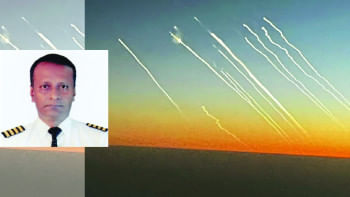The great Himalayan earthquake and its aftermath
A devastating earthquake struck in central and western parts of Nepal on April 25, 2015. By now, the death toll from the tremor measuring 7.8 on the Richter scale has crossed more than seven thousand people, with many more wounded. More than six million people in the 25 districts -- one person in every three households -- have been directly affected from the quake. The damages of physical properties have been colossal. More than one hundred thousand houses have been completely destroyed, and many more have been damaged beyond repair. Many historical and cultural heritages in Kathmandu valley have been rendered to the rubbles. The earthquake has come to Nepal as a Himalayan tragedy.
The April earthquake was a generational natural disaster in Nepal after the great earthquake in 1934. While the level of awareness on the various forms of natural disasters in Nepal-- including the possible damages from the earthquake -- have significantly increased since then, the country was not yet ready to cope with the disaster of such a huge magnitude that caused catastrophic damages within a few seconds. The country was simply not prepared for such a huge natural catastrophe nor did it have much experience or resources to cope with in the aftermath.
The intensity of damages from this earthquake has been strongly felt particularly in the densely populated capital city of Kathmandu valley and in the inaccessible and remote villages in central and western Nepal. The geographical terrain and the weather conditions have also hampered immediate rescue of victims. Despite the hazards, rescue works started instantaneously and immediately after the quake. Volunteers and the general public spontaneously came to the scene to ferry the victims to nearby hospitals. All security apparatuses, the government bureaucracy, medical professionals, health workers and the service providing agencies of the Government of Nepal have been at work round the clock for the rescue and relief of the quake victims. They have done a tremendous job to rescue many people safely from the rubble by putting their own lives in danger and by providing relief supplies to the victims.
There has been huge support and solidarity from all our friendly countries and the international community in the rescue and relief works of the quake victims. Within a short time after the quake, significant logistical and material support, and specialised rescue and relief teams and emergency medical units arrived in Nepal, which have done exemplary work to save the lives from the earthquake. There have been miracles even after six or seven days of the disaster to find survivors from the rubble.
We have been overwhelmed by the massive outpouring of support and solidarity from Bangladesh for the quake victims in Nepal, both at the government and the people's levels. Bangladesh was one of the first countries to promptly respond by sending a medical team and relief materials for the quake victims. Relief materials to the earthquake victims have instantaneously been flowing from various organisations, social groups, industries, businesses, educational institutions, NGOs – from various such quarters in Bangladesh. The relief materials consist of medicines, blankets, dried food, readymade garments, tents and tarpaulins, bottled water etc. This reflects the deep bonds between our two peoples and the genuine wish of the Bangladeshi people to help the people of Nepal in this difficult hour. The Embassy has also opened a special bank account for the relief of the quake victims in which we have been receiving a good pledge of relief assistance.
Meanwhile, the government faces a huge challenge for the relief and rehabilitation of the quake victims, particularly for people living in remote and inaccessible areas. People in those areas urgently need shelter, food, and emergency health and sanitation facilities. The basic provisions, such as light tents, tarpaulins, blankets, mattresses, food, and essential medicines need to be reached the affected people urgently and before the onset of the monsoon, which would make transportation of relief supplies still more difficult. The government alone is not in a position to meet this unforeseen and pressing demand of relief supplies to the quake victims; hence the need for greater international help and assistance.
The disastrous earthquake has caused irreparable losses and damages to Nepal's precious historical and cultural heritage sites. But the country is united, and will rise from the present natural disaster to restore and rebuild our iconic historical monuments. It is going to be a Herculean task demanding significant resources – both financial and material. There has already been a great deal of support coming in from our friendly countries and international organisations in the quest of restoring the centuries-old cultural heritage.
We are aware that the road to recovery will be long. It would take many years but we are resolute that we will rebuild those priceless monuments, and the cities and villages that have turned to rubble. No doubt, the cost of recovery and rebuilding would be staggering. The conservative estimate alone puts the figure at $ 10 billion. Hence the support of the international community becomes crucial in garnering the financial and technical assistance to Nepal for recovery, reconstruction, and rebuilding.
The recent earthquake has, no doubt, posed a great challenge to Nepal but it is also an opportunity to demonstrate resilience and the determination of the Nepali people to rebuild the nation. It is also time for us to resolve ourselves to redouble our efforts for political and economic transformation of the country and make Nepal a vibrant, democratic and prosperous country in South Asia. In this quest, we require goodwill, cooperation, understanding and support from all our friends.
The writer is Ambassador of Nepal to Bangladesh.
The article is an exclusive to The Daily Star.

 For all latest news, follow The Daily Star's Google News channel.
For all latest news, follow The Daily Star's Google News channel. 



Comments